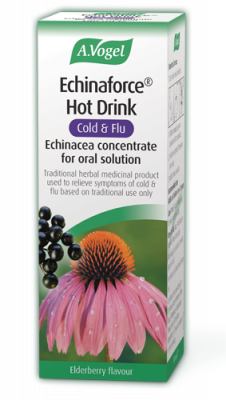An introduction to bronchitis & mild fever
Bronchitis is a condition that occurs when an irritant or infection causes inflammation and swelling to the lining of the bronchial tubes (the tubes that carry air to and from your lungs). As the irritated membranes of the bronchi swell and grow thicker, the tiny airways of the lungs become restricted.
A cough is the most common symptom of bronchitis. However, since acute bronchitis is most commonly caused by an infection and often follows upper respiratory infections such as a common cold, a mild fever and ‘cold-like’ symptoms such as chills and body aches can also occur.
Why does bronchitis cause fever?
A fever is actually a good thing! It’s important to know that your body is raising its temperature for a reason and that’s to fight off bacteria, viruses or infections. So developing a mild fever is a good sign that your immune system is doing its job.
Some believe that turning the heat up is the body’s way of fighting off bugs and germs by making your body a less comfortable place for them to be.
Since acute bronchitis is most commonly caused by viral infections, it is possible that a mild fever will occur, especially in the early stages of the infection. If your fever is 38°C (101°F) or below it is considered mild and usually nothing to worry about.
However, it is important to regularly check your temperature and to contact your doctor if you develop a high fever (a temperature above 38°C) or if your fever persists for too long. A high or constant fever can be an indication of a secondary infection such as pneumonia.
A mild fever is typically only associated with acute (short-term) bronchitis, which is caused by a viral (the most common cause) or bacterial infection. A fever is not usually present in bronchitis caused by airborne irritants such as fumes and pollution or chronic (long-term) bronchitis, which is commonly caused by smoking.
Are there any self-help measures?
When you have a fever, it’s natural to want to reduce it as quickly as possible, but this can actually be counterproductive and make your infection last longer. Since a fever is part of the body’s natural way of fighting the infection, it’s important not to suppress this action, but instead try to let it run its course. In most cases a fever will gradually reduce as the infection does, unless there is a secondary infection present.
While a fever can be unpleasant, there are several things that can help you to feel more comfortable while you wait for your immune system to do its job. You should:
Cool down: Doctors advise against lowering your body temperature too quickly. However there are simple ways to lower it gently to help ease the discomfort of a fever, including taking a lukewarm bath, sponging your body with lukewarm water or placing a cold compress or washcloth on your head, around your neck or on your wrists. These methods can all help to draw heat out of the body.
Drink plenty of water: When you have a fever, it is very easy for your body to become dehydrated. Dehydration can also cause your temperature to rise. Make sure you drink plenty of plain water and keep an eye on the colour of your urine (the paler it is the more hydrated you are; the darker it is the more dehydrated you are).
Get plenty of rest: When your body is fighting an infection, it’s important not to over-exert yourself. Get plenty of rest to allow your body to have enough energy for your immune system to do its job.
Eat right: Eating the wrong foods can also deprive your body of much-needed energy. Sugary, processed and fried foods are all harder for your body to digest, which takes up energy that should be used to fight off the infection. Therefore, it’s important to eat foods which are rich in nutrients such as fruit and vegetables (to help aid healing) and are easy for your body to digest (to save energy).
Homemade soups are a perfect example of nourishing foods as they provide essential nutrients that support the immune system and aid healing. Chicken soup is an excellent choice. As well as being easy to digest and soothing, scientists have found it also contains a substance known as carnosine, which supports the immune system, especially during the early stages of infection.1
Foods rich in vitamin C, such as strawberries, broccoli, bell peppers, sweet potatoes and tomatoes are good choices, since the vitamin C assists your immune system in fighting off infection.
Keep your home temperature at a comfortable level: Make sure your room temperature is not too high or too low. If the temperature in your home is too high it may prevent your body from releasing its excess heat, whilst too cold could cause you to shiver. This could make your fever worse as shivering is your body’s way of recognising that it needs to increase its internal temperature.
Wear comfortable clothing: It’s important not to trap the heat with extra layers of clothing and blankets, which can also raise your body temperature even more. When you have a fever, wear light, loose, comfortable clothes made of natural, breathable fibres such as cotton or silk to allow your body to release excess heat.
Go to bed with wet socks on: It may seem strange and just an old wives’ tale, but going to bed with wet socks on your feet can actually help you fight off a fever by stimulating your body's immune system.
Start by warming your feet up in warm water for 10 minutes. While your feet soak, get a thin pair of cotton socks and soak them in ice cold water. Wring them out slightly and put the wet socks on, then put a heavier pair of dry socks on top of the wet socks and go to bed. Continue this for several nights if necessary.
Are there any herbal remedies that can help?
If a mild fever is a symptom of your bronchitis, it’s likely an underlying infection may be having a part to play.
 Echinacea Hot Drink can be used up to five times daily to help to minimise the duration and severity of your symptoms, whilst also supporting your immune system longer-term.
Echinacea Hot Drink can be used up to five times daily to help to minimise the duration and severity of your symptoms, whilst also supporting your immune system longer-term.
Next, persistent coughs are often one of the other most prominent symptoms of bronchitis and so this may accompany your fever.
 If you experience a chesty or mucus cough, use the herbs Ivy and Thyme found in Bronchoforce to help ease your symptoms.
If you experience a chesty or mucus cough, use the herbs Ivy and Thyme found in Bronchoforce to help ease your symptoms.
Ivy is naturally anti-spasmodic and can work well to help loosen any stubborn mucus, whilst thyme is gently anti-septic, helping to thin mucus and make it easier to expel.
What about conventional medicines?
If a fever is making you feel very uncomfortable, you can try fever-reducing (antipyretic) over-the-counter medicines such as paracetamol (acetaminophen).
Antibiotics will only be prescribed if your doctor thinks your acute bronchitis is being caused by a bacterial infection
References
1. Management of the virulent influenza virus infection by oral formulation of nonhydrolized carnosine and isopeptide of carnosine attenuating proinflammatory cytokine-induced nitric oxide production, Am J Ther, (2012). (https://www.ncbi.nlm.nih.gov/pubmed/20841992)








